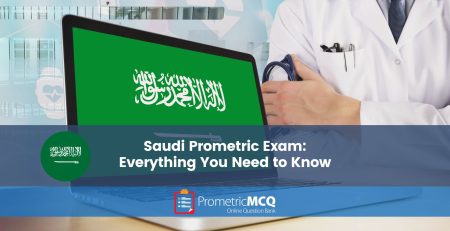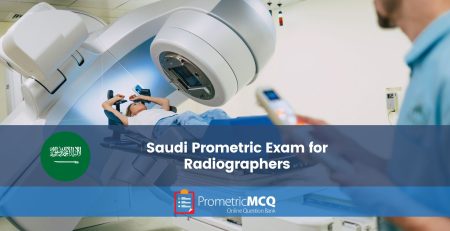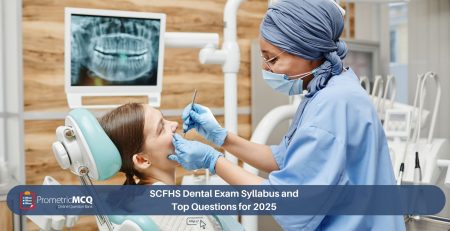
SNLE Saudi Nurse Exam: Top MCQs for Guaranteed Success
fatima@prometricmcq.com2025-09-17T15:40:57+00:00Table of Contents
ToggleSNLE Saudi Nurse Exam: Top MCQs for Guaranteed Success (2025)
The Saudi Nurse Licensing Exam (SNLE), administered by the Saudi Commission for Health Specialties (SCFHS), is the definitive gateway for nurses aspiring to practice in the Kingdom of Saudi Arabia. Passing this exam is not just a requirement; it is a validation of your skills against a high benchmark of international nursing standards. While the breadth of the nursing syllabus can seem overwhelming, success is not about memorizing every page of a textbook. It’s about mastering the art of the Multiple-Choice Question (MCQ).
The SNLE is a clinical reasoning exam disguised as a multiple-choice test. Each question is a puzzle—a clinical vignette that demands you to assess, analyze, prioritize, and act, just as you would at the bedside. Therefore, the single most effective preparation tool is not passive reading, but active engagement with high-quality, exam-style MCQs. By deconstructing these questions, you learn to think like the exam creators, identify patterns, and apply your knowledge under pressure.
This ultimate 2025 guide is built on this principle. We are providing you with more than just tips; we are offering a deep dive into the types of MCQs you will face, complete with detailed, expert-level rationales. This resource will break down the highest-yield topics, guide you through a strategic study plan centered on MCQ mastery, and answer your most pressing questions in a comprehensive FAQ section. This is your blueprint for guaranteed success on the SNLE.
Key Takeaways for MCQ Mastery
- MCQs are Training, Not Just Testing: Use practice questions to learn, not just to assess what you know. A detailed rationale is more valuable than a correct answer.
- Prioritization is King: Expect dozens of questions asking “Who do you see first?” or “What is the priority nursing action?”. Master the ABCs and Maslow’s Hierarchy.
- Safety is the Unspoken Rule: Every correct answer is the safest option for the patient. From medication rights to infection control, safety is the foundation of the exam.
- Know Your Fundamentals Cold: A huge percentage of the exam tests core nursing principles—the nursing process, fluid and electrolytes, vital signs—applied to complex scenarios.
- Practice, Analyze, Repeat: The key to success is a relentless cycle of doing MCQs, analyzing your mistakes in an error log, and reinforcing weak areas. For a full strategy, see our guide on passing the SCFHS exam on the first try.
High-Yield SNLE Topics: Where to Focus Your MCQ Practice
To use MCQs effectively, you must focus your practice on the topics that appear most frequently. The exam is comprehensive, but some areas are more heavily weighted than others. A deep dive into the Saudi Prometric exam syllabus for nurses reveals the following high-yield areas.
| High-Yield Clinical Area | Key Concepts to Master Through MCQs |
|---|---|
| Cardiovascular Nursing | Management of Myocardial Infarction (recognizing STEMI on an EKG strip, administering MONA), Heart Failure (distinguishing right vs. left-sided, daily weights, dietary teaching), and Hypertension (medication side effects, lifestyle modification). |
| Respiratory Nursing | Care of patients with COPD and Asthma (recognizing exacerbations, proper inhaler technique), Pneumonia (positioning, collecting sputum), and understanding ABG interpretation. |
| Endocrine Nursing | All aspects of Diabetes Mellitus are crucial. Master the differences between Type 1 and Type 2, the onset/peak/duration of different insulins, sick day rules, and the management of DKA vs. HHS. |
| Pharmacology Calculations | This is a guaranteed section. Practice daily. You must be able to calculate oral dosages, IV flow rates (mL/hr and gtts/min), and heparin/insulin infusions without error. |
| Infection Control | Know the exact precautions (standard, contact, droplet, airborne) for common diseases (e.g., TB, C. diff, Meningitis, Influenza). Questions on the correct sequence for donning and doffing PPE are very common. |
When reviewing a practice question, don’t just ask “What is the right answer?” Ask “Why is this the *most* right answer, and why are the other three options incorrect or less of a priority?” This deep analysis is the key.
Top SNLE Sample MCQs with In-Depth Rationales
Let’s put theory into practice. Here are examples of high-yield MCQs that mirror the style and complexity of the actual SNLE. Pay close attention to the detailed rationales. For more questions like these, our database of the latest Saudi Prometric exam questions is an invaluable tool.
MCQ 1: Prioritization of Care
The nurse on a medical-surgical unit has just received the morning report. Which of the following patients should the nurse assess first?
- A patient with pneumonia who has a temperature of 38.5°C and a productive cough.
- A patient with chronic heart failure who gained 1 kg in the last 24 hours and has 2+ pitting edema in the ankles.
- A patient with asthma who used their albuterol inhaler 20 minutes ago and is now reporting a fine tremor and a heart rate of 110 bpm.
- A patient who is 12 hours post-thyroidectomy and is complaining of tingling around the mouth and muscle spasms in their hand.
Correct Answer: D
Rationale: This is an ABC (Airway, Breathing, Circulation) question combined with an acute vs. chronic scenario. The patient who is post-thyroidectomy is exhibiting classic signs of hypocalcemia (perioral paresthesia, positive Trousseau’s sign – the hand spasm). This is a life-threatening complication because severe hypocalcemia can lead to laryngospasm and airway obstruction. This represents the most immediate threat to the patient’s life.
Why other options are incorrect:
A: A fever and productive cough are expected findings for a patient with pneumonia. While this patient needs monitoring and care, it is not an immediate life-threatening emergency.
B: Weight gain and edema are expected findings in a heart failure exacerbation. This requires intervention (like notifying the physician and administering diuretics), but it is a chronic issue that has developed over 24 hours and is less acute than the potential for airway compromise.
C: Tremors and tachycardia are known and common side effects of albuterol, a beta-agonist. While the nurse should assess the patient, these are expected side effects and not indicative of a life-threatening event.
MCQ 2: Pharmacology & Safety
A nurse is preparing to administer a scheduled dose of digoxin to a patient with atrial fibrillation. Which assessment finding would require the nurse to hold the medication and notify the physician?
- Apical heart rate of 62 bpm
- Serum potassium level of 3.1 mEq/L
- Patient reports seeing yellow halos around lights.
- Blood pressure of 110/70 mmHg
Correct Answer: C
Rationale: Seeing yellow halos (xanthopsia) is a classic and hallmark sign of digoxin toxicity. Administering another dose would be extremely dangerous and could lead to life-threatening arrhythmias. The nurse’s priority is to recognize this sign of toxicity, hold the dose, and immediately report it to the healthcare provider. While the potassium level is also a concern, the visual disturbance is a definitive sign that the drug has reached toxic levels.
Why other options are incorrect:
A: Digoxin is typically held for an apical heart rate below 60 bpm in an adult. A rate of 62 bpm is acceptable.
B: A potassium level of 3.1 mEq/L is low (hypokalemia). Hypokalemia potentiates the effect of digoxin and increases the risk of toxicity. This is a very important finding and must be reported, but the presence of an actual sign of toxicity (yellow halos) is the more urgent reason to hold the dose.
D: A blood pressure of 110/70 mmHg is within normal limits and is not related to the administration of digoxin.
Frequently Asked Questions (FAQs) for the SNLE Exam
The SNLE stands for the Saudi Nurse Licensing Exam. It is the mandatory professional licensing exam administered by the Saudi Commission for Health Specialties (SCFHS) for all nurses (both Saudi citizens and expatriates) who wish to practice in the Kingdom of Saudi Arabia. Passing it is the first step toward getting your SCFHS license.
The exam is scored out of 800, with an official passing score set at 500. This is approximately 62.5%. However, because the exam uses scaled scoring to ensure fairness across different test versions, your preparation goal should be to consistently achieve 70-75% on high-quality practice exams to build a safe margin for passing.
The application process is done entirely online. It involves creating a profile on the SCFHS’s Mumaris Plus portal, submitting your documents for verification, and then scheduling your exam date through the Prometric website once you receive your eligibility number. Our detailed guide explains exactly how to apply for the Saudi Prometric exam for nurses.
The SNLE for Nurse Specialists (Registered Nurses) is a 3-hour (180 minutes) exam consisting of 150 multiple-choice questions. This gives you an average of 1 minute and 12 seconds per question. Time management is crucial.
After you pass the SNLE, you must complete two critical steps. First is the Primary Source Verification (PSV) of your credentials by the DataFlow Group. Second is completing your professional classification and registration on the Mumaris Plus portal. A positive DataFlow report is required for Mumaris. For more details, see our guide on the SCFHS DataFlow process.
The most proven strategy is to use a combination of a trusted NCLEX-RN review book (like Saunders Comprehensive Review) for content and a dedicated, high-quality SNLE question bank for practice. The question bank is the more critical tool, as it hones your test-taking skills. Focus on resources that provide detailed rationales for both correct and incorrect answers.
The exam is a clinical competency test based on international standards. It does not test knowledge of local culture or Islamic law. However, it does test your understanding of professional ethics and culturally sensitive care, which are core nursing competencies worldwide. The official SCFHS website outlines a professional code of ethics that is aligned with these global standards.
Candidates are typically allowed up to three attempts to pass the exam. If you fail the third attempt, you may be required to undergo a period of professional re-training as determined by the SCFHS before you can apply for a fourth attempt. It is highly advisable to prepare thoroughly to avoid this scenario.
The ability to prioritize. The exam is filled with scenarios where all patients have needs, but one patient has a need that is more life-threatening than the others. You must be able to quickly and accurately identify the most unstable patient using frameworks like Airway-Breathing-Circulation (ABCs), Maslow’s Hierarchy of Needs, and the nursing process.
Success is directly correlated with the quality and quantity of your MCQ practice. It is essential to use a resource that is continuously updated and reflects the current style of the SNLE. A comprehensive QBank with thousands of questions, detailed rationales, and performance analytics is the key. You can find such a dedicated resource at SCFHS Nursing Exam MCQs.
Conclusion: From Preparation to Professional Practice
The SNLE is a significant challenge, but it is a challenge you can and will overcome with the right strategy. By shifting your focus from passive learning to active problem-solving with high-quality MCQs, you are not just studying for a test; you are training to be a critical-thinking, safety-conscious nurse ready for the demands of practicing in Saudi Arabia. Embrace this MCQ-centric approach, remain disciplined in your preparation, and you will walk into the Prometric center with the skills and confidence needed to earn your license on the very first try.
Ready to Transform Your Practice into a Passing Score?
Our premium SCFHS Nursing QBank provides thousands of high-yield, case-based MCQs with detailed expert rationales and simulated exams. It is the ultimate tool to build your confidence and guarantee your success on the first attempt.










